| |
|
In the 1960s, Ipswich went mad.
Town planners foresaw a rise in the town's population
towards half a million people, and so with natural
excitement they decided to cross and encircle the
existing town centre with a network of dual carriageways
lined with office blocks. They didn't get very far with
their plans before the men in white coats came and took
them away, releasing them into the wild somewhere like
Croydon or Wolverhampton, but the towering Civic Centre,
the brutalist police station and the Civic Drive road
system were left as evidence of their ambitions. The
Civic Centre and the police station, both which stood
directly opposite this church, have since been
demolished, but the four lane Civic Drive still cuts
across what was the Mount residential area, the little
terraces all demolished to make way for the 20th century,
and separates St Matthew from the rest of the town
centre.
Today, the Ipswich plan designates this whole area for
residential use, and the modern civil servants have moved
down to the river. This new plan, if it emerges, can only
serve the church well, sitting beside Civic Drive as it
does. The church is perhaps less well-known than the
other working town centre churches. Partly, this is
because it is the only one of them which is kept locked,
but also because it requires an effort to find it and get
across to it if you are a visitor. Because of this, many
people don't realise that the church contains a treasure
of national importance. This is the early 16th Century
font, which is quite unlike any other in Suffolk, and is
perhaps unique in England.This
must once have been quite a small building, but events
over the centuries have enlarged into the church we see
today. The core is 15th Century, including the lower part
of the tower. The 19th Century expansion was substantial,
made necessary by the proximity of the Ipswich Barracks,
for this became the Garrison church. This explains the
size of the aisles which are as wide as the nave, and
were intended to increase capacity as much as to allow
for the revival of processions. The chancel was also
rebuilt, but retained its medieval roof.
Until 1970 the church was hemmed in to the east, but the
construction of Civic Drive opened up this view, which
isn't a particularly good one. This end of the church is
entirely Victorian, and when you look at it you realise
that it was built into existing buildings and wasn't
intended to be seen. Because of this, it comes as a
surprise to find that the west end on Portman Road is by
contrast quite pastoral, a pretty setting for the tower.
Before the destruction of the houses to the east this
would have been the familiar view, the churchyard
stretching away to the south, but this in turn was partly
built over in the 1960s with the construction of the new
roads and of a church school. The part of the graveyard
immediately beyond the chancel on Civic Drive was turned
into a small garden. A footpath runs along the north side
which will bring you through to the main entrance, the
west door under the tower. You step into a broadly
Victorian interior, and find the font in the north aisle.
East Anglia is famous for its Seven Sacrament fonts, 13
of which are in Suffolk. These show the seven sacraments
of the Catholic Church, and are rare survivals. So much
English medieval Catholic iconography was destroyed by
the Protestant reformers of the 16th century, and the
Puritans of the 17th century. Here at St Matthew we find
an even rarer survival of England's Catholic past, a font
whose panels show a sequence of images of events in the
life of the Blessed Virgin Mary.
Before describing it, I have to make the point that this
really is one of the dozen most important and significant
medieval art survivals in Suffolk, and one of the finest
late medieval fonts in England. There is nothing as good
as this in the Victorian and Albert Museum, or in the
British Museum. I make this point simply because on every
occasion that I have visited, the person accompanying me
(they don't let you visit the church on your own) did not
seem to realise quite how important the font was, and
gave the impression that the parish, though they care for
it lovingly, also did not realise what a treasure, what a
jewel, they had on the premises. "It's quite
pretty," said the lady when I visited in September
2016. The leaflet in the church describes it as 14th
Century, which the nice lady took as holy writ and didn't
really believe me when I suggested that it wasn't.
In fact, it was made during the second decade of the 16th
Century. Of the eight
panels, one has a Tudor rose and another a foliage
pattern, but five of them depict events in the devotional
story of Mary, mother of Jesus. These five reliefs, and a
sixth of the Baptism of Christ, are amazing art objects.
They show the Annunciation to the Blessed Virgin with
Gabriel unfurling a banner from which a dove emerges to
whisper in Mary's ear; The Adoration of the Magi, with
the wise men pulling a blanket away from the Blessed
Virgin and child as if to symbolise their revelation to
the world; the Assumption of the Blessed Virgin, with
Mary radiating glory in a mandala, which four angels use
to convey her up to heaven in bodily form; the Coronation
of the Queen of Heaven, the crowned figures of God the
Father and God the Son placing a crown on the Blessed
Virgin's head while the Dove of the Holy Spirit races
down directly above her; and the Mother of God Enthroned, the crowned figure of the Blessed
Virgin sitting on the left of and looking at (and thus
paying homage to) her crowned son on the right, who is
holding an orb.
The late Dr John Blatchly thought
that this last panel of the Mother of God enthroned was
intended as a representation of Catherine of Aragon and
her husband Henry VIII. The evidence for this is
circumstantial, but there is no doubt that this font is
an artifact of the ongoing early 16th Century drama which
would eventually result in the English Reformation. John
Blatchly's research showed that this font was paid for
and installed by the rector of St Matthew, one John
Bailey, to celebrate the Miracle of the Maid of Ipswich,
which occured in this very parish in 1516 and was held in
renown all over England in the few short years left
before the Reformation intervened. The popularity of the
Miracle, in which Joan, a young Ipswich girl, has a
near-death encounter and experiences visions of the
Virgin Mary, was widely used by the Catholic Church as a
buttress against the murmurings of reformers.
In their book The Miracles of
Lady Lane, John Blatchly and Diarmaid MacCulloch
give a fascinating and often convoluted account of the
battles between Bailey and a much more significant local
figure, Cardinal Thomas Wolsey. Ipswich was Wolsey's
power base, and he attempted to consolidate his power by
taking control of the Shrine of Our Lady of Grace of
Ipswich which just happened to be in the parish of St
Matthew, a hundred yards or so to the east of this
church. The shrine was one of the most popular pilgrimage
sites in England. Bailey's celebration of the Miracle was
partly a way of competing with Wolsey for fame and
influence in the town, but also of increasing his own
hold on control of the Shrine. Those who visited the
shrine would also come to St Matthew and tell their bedes
around the panels of the font. The devotion to Our Lady
of Grace and the celebration of the Miracle of the Maid
of Ipswich would become intertwined. Church and shrine
would become inseparable parts of the same pilgrim
experience. Between 1517 and 1522, both Henry VIII and
Catherine of Aragon made journeys to the shrine, set
beside the Westgate in the parish of St Matthew. They
probably visited the church as well. Other visitors
included the the future saint Thomas More, and of course
Wolsey himself. But in 1525 Bailey died and left the way
open for the Cardinal, who in his turn would completely
over-reach himself and fall in his own way just five
years later. Henry's divorce from Catherine would entail
a break with Rome and over the next thirty years the
birth of a new Church of England. It is the kind of thing
Trollope would have written about if he had been around
in the 16th Century.
Blatchly and MacCulloch's book is
memorable as a picture of the incredible religious
fervour in Ipswich in the early years of the 16th
Century, a tale of near-hysterical enthusiasms that would
spill over into passion and violence. Blatchly notes that
the sequence of at least some of the Marian images on the
font was replicated by a sequence of inns down the mile
of Ipswich's main street, now the line of Carr Street,
Tavern Street and Westgate Street, which led to the
shrine. One of the inns, the Salutation (ie,
Annunciation) at the start of Carr Street survives in
business under the same name to this day. But in time of
course Ipswich would become well-known as the most
puritan of towns in the most puritan of England's
regions.
Remarkably, two of the four figures
around the base are probably intended as Joan, the Maid
of Ipswich, and John Bailey the Rector himself.
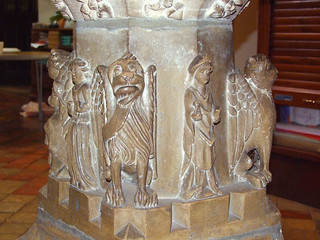
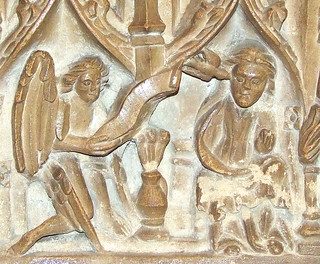  
  
Most guide books describe the
panels of the font as the five Joyful Mysteries of the
Rosary. In fact, this is technically not the case,
although certainly the font was intended for use in
rosary meditations. We know that the rosary was a hugely
popular devotion in medieval England, and that a persons
'bedes' were their most valued possession. They played a
major part in personal devotion, but were also important
as a way of participating in the liturgy, and as an
expression of communal piety. Many pre-Reformation
memorials show people holding their rosary beads.
However, what we now think of as the Rosary sequence only
dates from the 14th century or so, and was one among
several in common usage. Praying with the rosary had been
greatly popularised in England by St Thomas of Canterbury
in the 12th century, who devised a series of seven joyful
mysteries, including the Adoration of the Magi and the
Assumption of the Blessed Virgin. Most sequences were of
five meditations. In time, the Joyful Mysteries would
come to be Mary's earthly experiences, and the Glorious
Mysteries her heavenly ones.
Because personal devotion was considered a diversion from
congregational worship, and Marian devotion was thought
superstitious, the rosary was completely anathematised by
the 16th century Protestant reformers, and attempts were
made to write it out of history by destroying images of
it on brasses and memorials. Within forty years of this
font being produced, use of rosary beads was a criminal
act in England.
The survival of an image of the Assumption is
particularly interesting. We still have much surviving
evidence of religious life in England before the Church
of England came along, but it does not really reveal to
us the relative significance of different devotions,
simply because some of the major cults and their images
were ruthlessly rooted out and destroyed. The Assumption
is a case in point. 15th and early 16th Century wills and
bequests reveal a great devotion to the Blessed Virgin,
particularly to the feast of the Assumption, which is
celebrated on August 15th.
This is at the height of the harvest, of course, and it
is not difficult to see the connection between this feast
and the culmination of the farming year, or the
importance to farmworkers of a festival at this time.
More than 200 Suffolk parish churches were dedicated to
the Assumption. When the dedications of Anglican churches
were restored in the 19th century after several centuries
of disuse these generally became 'St Mary', although some
have been restored correctly since, at Haughley and
Ufford for example. The Church of England, of course,
does not recognise the doctrine of the Assumption.
Of equal significance are the other images, all
remarkable survivals. And why the Baptism of Christ? In
fact, this is the most common 'odd panel out' on the
Seven Sacrament fonts, and reminds us of the significance
of baptism in the medieval church. It was the sacrament
by which infants received their mystical commission to
the Christian life and to the daily life of the parish,
and was by total immersion, hence the size of medieval
font bowls.
Within thirty years of this font
being installed here, injunctions against images
proscribed its panels. Most likely it was plastered over,
for the parish would still need a font. The bowl still
shows traces of plaster today.
The font is not quite the only
medieval survival here, for the north aisle also retains
panels from the rood screen, built into a 19th century
screen. You might miss these, because ordinarily chairs
are stacked against them. Three of the panels show
bishops, and the other two show cheering crowds of seven
and nine people respectively. I do not think that these
can be in their original configuration. Roy Tricker
thought that the crowds were portraits of parishioners,
which may be so, in which case these may besurviving
panels of the screen to the chantry altar of the guild of
Erasmus, which was established here.
There is clear evidence of the location of at least one
nave altar, since a squint kicks in from the north aisle.
There are two good 17th century wall memorials in the
chancel, the best being to Anthony Penning and his wife
depicting their children weeping, some holding skulls to
show that they pre-deceased their parents.
| Much of the 19th century
woodwork is from the workshops of two major 19th
century Ipswich carpenters, Henry Ringham and
John Corder. Ringham's work can be found in
several Suffolk churches, most notably St Mary le
Tower, Woolpit and Great Bealings, while Corder
was an architect responsible for several
restorations, including Swilland. Both have
Ipswich roads named after them. The church has an extensive
collection of late 19th and early 20th Century
glass, not all of it good, but happily by a wide
variety of workshops. The great curiosity is the
window in the east end of the south aisle, which
depicts Jane Trimmer Gaye, wife of a 19th Century
rector, flanked by female members of her
husband's flock with images of birth and
death. It was designed by her brother Frank
Howard, and made by George Hedgeland. Another
oddity is Percy Bacon's Christ flanked by St
Edmund and St Felix - for the last hundred years
the Saints have stood here with their names
transposed.
There is a frankly functional modern screen, with
a curious Anglo-catholic style rood which looks
most out of place, for St Matthew today is very
much in the evangelical tradition. But the lady
who allowed me entry told me that people liked
it, so I expect nobody minds too much.
|
|
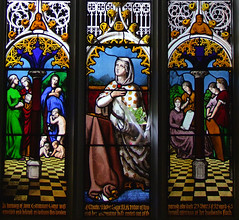 |
Simon
Knott, August 2020
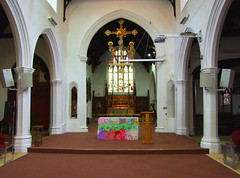 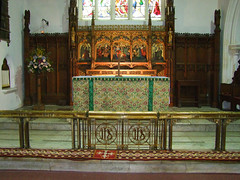 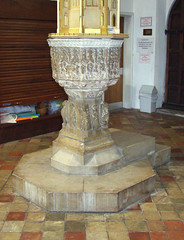 
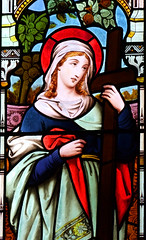 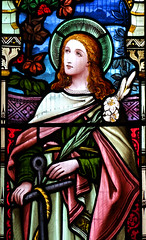 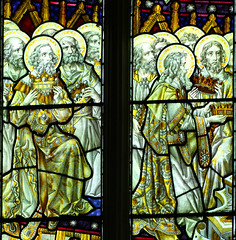 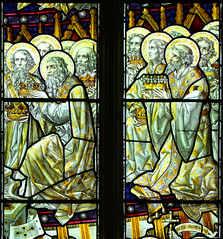
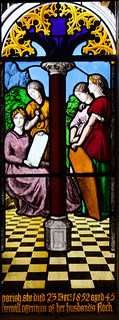 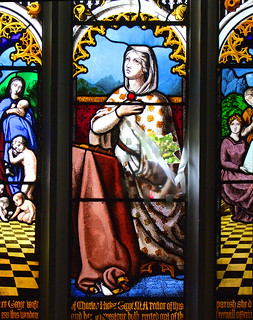 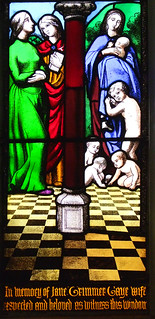 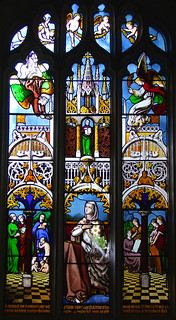
  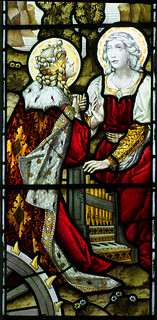   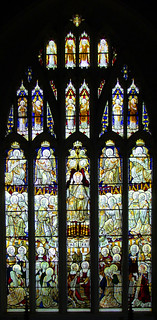
 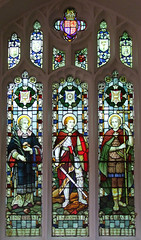 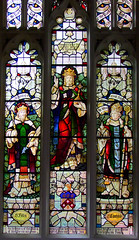 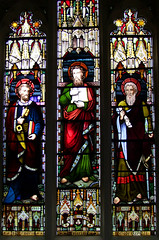 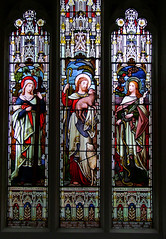 
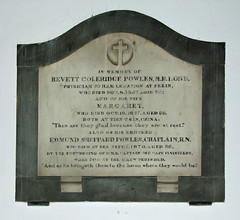  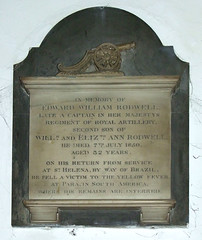 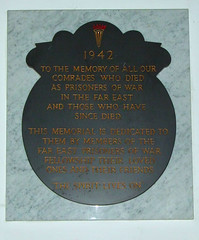
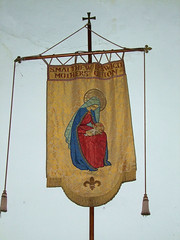 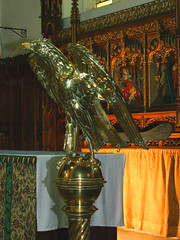 
|
|
|

